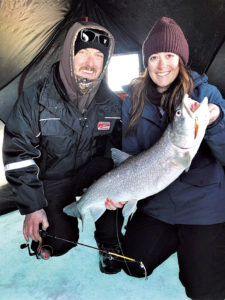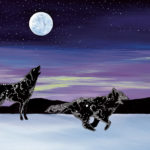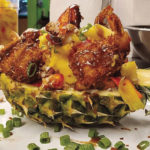The eastern tip of Thunder Bay, on the Canadian side of Lake Superior, is known as Bays End. I am not exactly sure where Bays End officially starts, but a line that runs south and north from the western tip of Caribou Island is about right. Some might say it starts from the Conservation Area and the launch at Silver Harbour and I won’t argue with that.
Bays End freezes up sooner than the rest of the bay, normally by mid-January. Once the ice is solid, anglers begin to ply the expansive waters of the bay on foot, or via snowmobile or ATV. The snow depth varies a lot each winter and there can be some substantial ice ridges as well.
Bays End provides a unique and diverse winter fishery, with some of the best fishing happening in February and March. Here is a breakdown of the species you can catch and how to take them.
Lake Trout
The bread-and-butter fish of Bays End, lake trout are both numerous and grow quite large, although a 20-pounder is a monster here. Four decades ago, the lake trout fishery came back after a long period of decline, largely due to lamprey predation and overfishing. Although lamprey scars are still evident on many fish, the laker population remains strong. Most lake trout are caught in water from 40 to 100 feet, although they can be found both deeper and shallower. There are not many places in the bay where you can’t catch a laker, but the 60- to 80-foot trough on the north side of Caribou is a consistent hot spot as is the deep water closer to the Sibley Peninsula. The western tip of Caribou Island also holds a lot of lakers. I’ve found the best and simplest way to catch lake trout in Bays End is to jig spoons. A silver Swedish Pimple weighing from a half ounce to an ounce will work wonders. The weight and size of the spoon will depend on the depth you are fishing. An aggressive jig-drop-jig action seems to catch the most lake trout, with many hitting on the drop. Other good laker spoons include the Krocodile, Hopkins and Buzz Bomb. Lakers will also hit a frozen cisco that’s hung or laid on the bottom as a set line. Most of the lake trout will be close to bottom, although I have had lakers come in well off bottom to hit a spoon being dropped or retrieved. A flasher or ice depth finder will be a big help.

Whitefish and Herring
Whitefish and herring are abundant in Bays End and are often found in the same general areas. Whitefish tend to be bottom oriented, however, and herring suspend, often very close to the ice. Bays End whitefish can grow large, with some specimens clocking in at 27-28 inches, with the occasional giant topping 30 inches. These big whiteys are old and are good candidates for release. The best eating whitefish are 20 to 26 inches. Herring do not grow as large as whitefish on average, but some specimens approach 23-24 inches. Herring have a different mouth than a whitefish and the flesh has more oil. Jigging lighter-weight spoons will catch both whitefish and herring. I find the silver/brass Williams Whitefish a consistent killer for both species, with the Hopkins Smoothie a close second. Lighter spoons with a good flutter seem to trigger whitefish to hit. I’ve had the best luck for whitefish in water from 20 to 30 feet deep, although my largest fish last year, a 27-incher, was caught in less than 15 feet. Some anglers make large holes to view fish in the clear water. I used an Aqua Vue camera last year and was amazed at how many fish I saw with it.
Steelhead
Lake Superior has a naturalized population of rainbow trout, a fish that is usually called a steelhead. The fish run rivers and creeks in the spring to spawn but live most of the time in Lake Superior. These fish are active under the ice and tend to be in shallower water, often off points or near river mouths. Steelhead can be tricky to pattern, but what you may not get in numbers is made up for by the fight these trout lay out. Last winter, my father Gord Senior was jigging in about 20 feet of water when a steelhead smashed his spoon. The strike was so hard it broke his rod, but he did manage to land the fish with a little assist by provincial conservation officer Davis Viehbeck, who just happened to be checking us at the time. Jigged spoons, as well as white tube jigs and jig flies are all good for catching steelhead. I’ve also caught them with a minnow on a set line. Please consider releasing steelhead as they are not numerous and will be staging for the spawn.
Other Fish
There are a few other species occasionally caught in Bays End. Burbot are common and can be caught on bottom in water from 20 to 100 feet deep. They also readily take live and dead bait. Burbot are freshwater fish and are quite good to eat. Last winter, two of my angling partners caught brown trout ice fishing in Bays End. These are not a common catch but seem to be making inroads north. It will be interesting to see if any show up this winter. Chinook salmon and splake are also found in Bays End but are both very rare catches. I know of one chinook landed by an ice angler last winter. There are also the occasional coaster brook trout in Bays End, although they too are rare. Brook trout season runs from the fourth Saturday in April until Labour Day in September, so the fish are closed to angling in the winter on Superior. Brown trout, splake and chinook are open in the winter on Superior.
Make yourself aware of the Ontario regulations, seasons and limits on Lake Superior by checking them at: bit.ly/ontariozone9. Good luck this winter.






